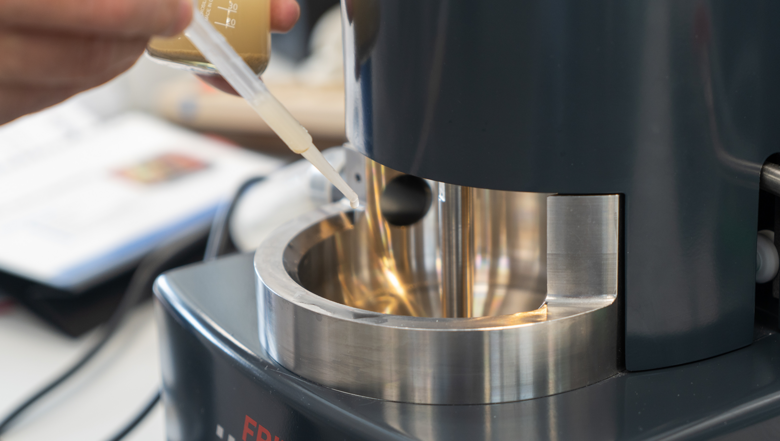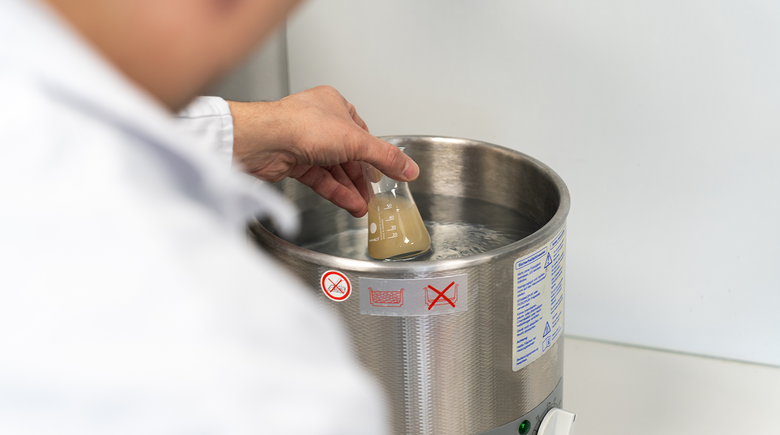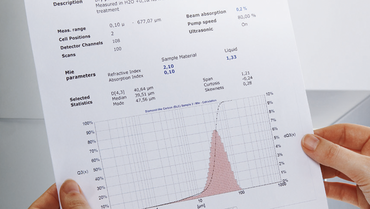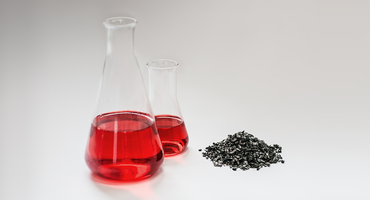Tips for dispersing statically charged or hydrophobic sample material for particle measurement
The computer is only as smart as its user. We all know this saying and it applies at least as much to high precision, fully automatic analytical instruments, such as the FRITSCH Particle Sizer ANALYSETTE 22 NeXT. Even though much is already done automatically here, it is important for the user to know a few tricks and tips, especially with samples that are difficult to disperse, in order to ensure an optimal analysis.
Particle measurement of easy-to-disperse samples
Many samples require special preparation for measurement due to their material properties. If dispersion is necessary to be able to measure the primary particles, wet dispersion is the ideal form for most samples. Preliminary tests must be carried out to check in which way the sample material can be wetted and dispersed. The liquid should wet the solid as spontaneously and completely as possible! In wet dispersion, the sample material is placed in a closed liquid circuit and continuously pumped through the measuring cell. Problem-free samples that are immersed directly in the water surface without much effort and do not have a high fine content can be fed directly into the wet dispersion unit of the ANALYSETTE 22 NeXT as a solid in portions and measured reproducibly. In the case of more strongly bound agglomerates, a preceding ultrasonic treatment of the sample is often helpful.
During the pumping process in the measuring circuit, ultrasound can be coupled in to destroy the agglomerates and obtain individual, separated particles. The additional ultrasound support with the maximum possible power generally shortens the dispersion time considerably.
Samples that are easy to disperse are characterised by low reactivity and simple dissolution behaviour. Prominent examples are sand or aluminium oxide. In the case of sand, only the first phase is critical as a duration, during which the fine fraction detaches from the surface of the coarse particles and enters into solution. As a result, a turbid solution appears above the coarse-grained sediment. In order not to falsify the final result, a representative subsample must be taken without neglecting sedimented particles. A fine alumina sample is even easier to analyse. Sedimentation or insufficient dispersion usually play no role here.
Preparing samples that are more difficult to disperse for particle measurement
In case of static charge (e.g. polymers) or hydrophobic properties (e.g. baking cocoa), a spatula amount of the substance should be placed in a small 50 ml Erlenmeyer flask and then first mixed with 1 (to 2) drops of a wetting agent (surfactant, or diluted surfactant solution) and mixed with a glass rod until the sample is completely wetted. Now add water drop by drop and continue stirring. The now available approx. 20-30 ml suspension is dispersed in the ultrasonic bath. If the sample is already in the dispersion unit and floats on the surface, the sample can still be wetted as follows: a small drop of a wetting agent (e.g. Dusazin 901, Teepol, Tween 80 or Pril) is applied/touched to the liquid surface with a glass rod or the tip of a spatula and distributed. It is immediately noticeable that the formed skin breaks open and the fine particles go into suspension. This is followed by treatment with ultrasound in order to support the chemical effectiveness of the above-mentioned surfactants physically.

The vast majority of samples reach their final dispersed phase through this treatment, and thus a reproducible particle size distribution. However, there are one or two samples that do not react to certain surfactants or even the ultrasonic treatment as expected. In this case, multiple measurements become significantly coarser or visibly aggregate in the ultrasonic bath. Representatives of this sample group would be, for example, special metal alloys or isolated active pharmaceutical ingredients.
Your particle size measurement is only as good as your dispersing process
The search for a suitable surfactant and the subsequent dispersion process can be relatively quick and easy on the one hand, but on the other hand it can seem quite tedious in some cases. However, it should never be treated carelessly, as the dispersion of the sample has an enormous influence on the quality of the particle measurement. Various literature sources as well as the Fritsch database or our competent team of advisors can be used for targeted orientation. The final result is a reproducible method for each sample, which offers every user the possibility to carry out a reliable and meaningful particle size analysis.
-
Download the FRITSCH-report as PDF file




